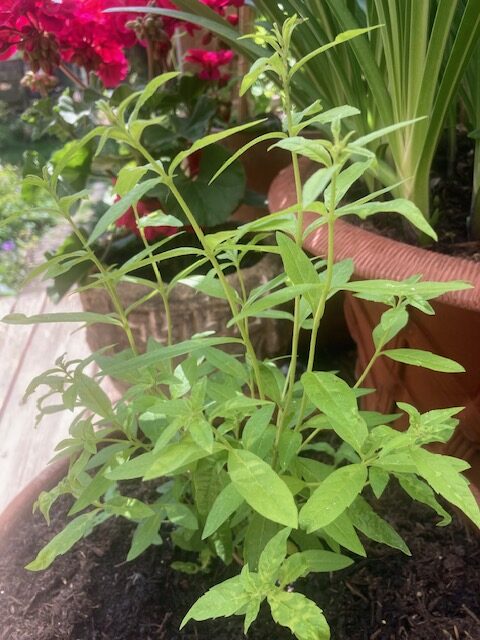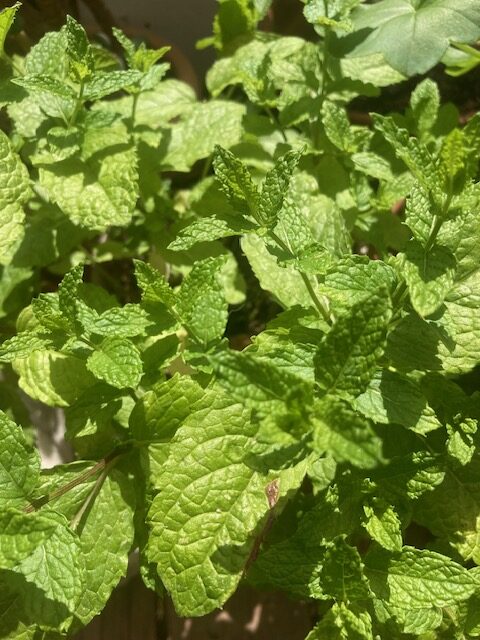Throughout winter my greenhouse played host to many miserable looking specimens, semi-hibernating through the coldest months, but there was one that I am always particularly delighted to see leap back into life come spring. Bright and citrusy, lemon verbena provides perhaps the best scent in the garden – rub the leaves and bring your fingers to your nose and it is filled with the scent of lemon sherbet – and it makes possibly the best tisane.
A tisane is a fancy word for a herbal tea, and one made by steeping petals, seeds and leaves in boiled water to bring out their flavours – the name suggests something with a little more romance than reaching for the dusty mint teabags in the back of your cupboards, these are teas made by wandering and plucking at the height of the season. We are really coming into the tisane season now, as the growth on herbals plants is young and vibrant and at its most pungent.

Lemon verbena is just one of many good tisane plants. It is a tender perennial, and dislikes cold, wet roots and will drop its leaves in winter, but sheltered from frost and kept dry it should come back. While some people can grow it outdoors in the mildest areas, even here in the southwest of England I have never quite managed the resurrection part – except in my greenhouse. Grown in a terracotta pot there, with good drainage, it thrives in full sun and rewards you with a harvest that can be used fresh or dried for year-round use.
In this way the greenhouse, even the unheated one, can be the gateway to this wonderfully fragrant world of homegrown herbal teas. Some other possibilities: stevia is another tender perennial that can fare better in the greenhouse than it would out of doors. It is a naturally sweet leaf that’s increasingly popular as a sugar alternative and while not as intensely aromatic as other herbs, its mild sweetness can soften bitter blends. Like verbena, stevia doesn’t like frost, so keep it under glass in the cooler months. Tulsi, or holy basil, another greenhouse candidate, brings a spicy, clove-like warmth to tisanes and is revered in Ayurvedic traditions for its calming properties. Pineapple sage, with its scarlet blooms and tropical scent, is worth a try too, though it needs warmth early on to get established.

Of course, many of the best herbal tea plants are perfectly content in the open air. Mint is a classic, easy to grow, quick to establish, and vigorous to the point of being invasive. Keep it in pots to contain its spread, and explore varieties such as spearmint, Moroccan mint, or chocolate mint for subtle differences in flavour. Chamomile is a beautiful and useful addition to any garden bed; German chamomile, an annual, produces masses of small daisy-like flowers that make a soothing brew. Fennel fronds lend a delicate aniseed note to tisane blends, especially when used fresh. Even lavender works beautifully in tisanes, especially when combined with lemon-scented herbs.
To harvest, pick leaves and flowers in the morning once the dew has dried, when the essential oils are at their peak. You can make a tisane immediately – push some sprigs into a cup or a teapot, pour over boiled water and steep for five minutes. Experiment with different mixtures or stick to one type – lemon verbena and mint is particularly delicious. Tie those sprigs you want to store up in small bundles and hang in a warm, airy place out of direct sun, or spread on trays to dry. Once crisp, store in clean glass jars, labelled and dated.
There’s something deeply satisfying about harvesting a few sprigs from your own plants and pouring boiling water over them. It’s a quiet ritual, one rooted in the seasons, and made possible by a little planning, and perhaps a greenhouse to lend a hand.


